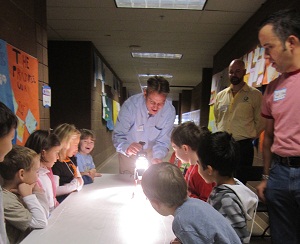Colorado school gets solar demonstration, part 2
 Jones told the kids about how solar panels collect the sun’s energy and that if we could capture all of the sun’s energy, it would only take an hour for us to generate enough power for the whole world.
Jones told the kids about how solar panels collect the sun’s energy and that if we could capture all of the sun’s energy, it would only take an hour for us to generate enough power for the whole world.
“Whoa,” and “wow” came from wide-eyed faces with dropped jaws.
Jones then showed the kids slides featuring solar-powered houses, cars, motorcycles, lawnmowers, and even a solar-powered airplane.
“That was really cool,” Colin said. “I didn’t know all that before.”
Then Jones and Hamilton showed students their Vibrant solar panel. They counted the solar cells and did a little math together to determine that the panel would produce 30 volts of energy.
Jones compared the panels to batteries so the kids could get an idea of how much energy they made. A typical AA battery found in their toys, Jones said, produced three times as much energy as one solar cell. That meant that the panel altogether made as much energy as 10 batteries.
“The problem with batteries, though,” Jones said, “is what?”
They run out of energy, he explained. But as long as the sun keeps shining on the solar panel, it will never stop producing energy.
Jingui raised his hand and asked how power gets from the sun to the things it powers without wires, how it gives energy to solar panels.
“You know how when you’re in the mountains, skiing and the air temperature is really cold,” Jones asked, “but you’re still getting a sunburn, and you can still feel the sun’s energy on your skin? That’s radiation; the energy radiates.”
To demonstrate how solar panels work, Jones and Hamilton brought a small plastic car with a little electric motor and small group of solar panels to power it. They shined a special light, simulating the sun, onto the panels and the car powered itself forward through the hallway in front of the kids.
They came back into the classroom raising their hands to Ekblade’s question about whether or not they thought they could invent something solar powered.
“They’ll be sending you their resumes in no time,” Ekblade said to Jones and Hamilton.
Hamilton said he and Jones wanted to present at the school so they could show kids how accessible this technology is becoming. Hamilton said he never got to see solar in action as a kid, and the technology has progressed to the point that it’s affordable for regular people and becoming a bigger part of reality for these kids.
Laney said she already knew a lot about solar because her parents have solar panels on her roof at home.
But she definitely thought the little solar-powered car was cool.
Pictured: Ben Jones, with Chris Hamilton (right) looking on, demonstrates a solar-powered car.



